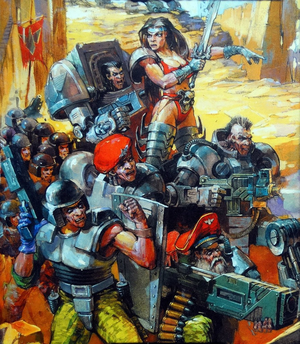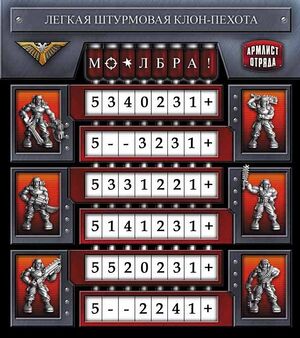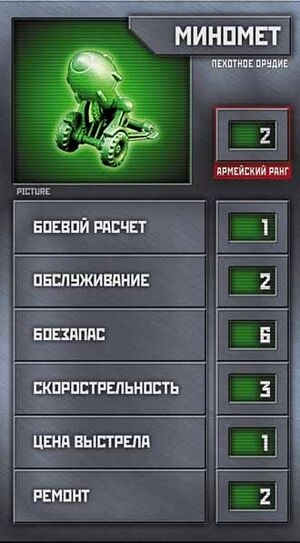Бpoнeпeхoтa: Difference between revisions
No edit summary |
1d4chan>StarsysAnon No edit summary |
||
| Line 12: | Line 12: | ||
===2002 edition=== | ===2002 edition=== | ||
Understanding the rules of the 2002 edition fully requires a full rulebook to be found, which was only distributed in a single boxed set (and probably on the company site). Furthermore, there were at least two incomplete versions of the ruleset - a simplified one for small sets (that featured mechanics for "virtual fire" for infantry, which is just a fancy way of saying that they don't actually fire plastic shells) and a more comprehensive one for bigger sets (that, for some reason, did not feature infantry fire at all). Still, these two might be enough to get the overall feeling of the game. | |||
[[File:Light assault clone infantry v2002.jpg|thumb|right|A 2002 statlist ("armlist") of a Polaris Empire light assault clone infantry squad. Attributes, left to right: speed, weapon range, firepower, leadership, armor, melee, army rank, special abilities. According to some opinions, the + special ability signified a jump pack.]] | |||
The game is intended for at least two players each assembling their forces of infantry, artillery, vehicles, and fortifications on an army rating budget. For artillery and vehicles, the price calculation is straightforward - their army rank doubles as their cost. Fortifications (composed of "брониты"/"armorite" plates) cost 1/2 pt per plate, while the cost of an infantry squad is equal to the number of its members plus the entire squad's army rank (so, a squad of clones pictured here costs 7 pts).<br /> | |||
Gameplay consists of rounds. Every turn, each player generates an action point pool to use for activations and orders, which is equal to d12+their army rating, adjusted for losses and trophies. The player with higher action points for the round decides whether to activate first or second.<br /> | |||
Players then alternate, activating their units one at a time; any number and type of infantry can be connected base-to-base into a formation, which activates in its entirety. Activating the same unit more than once over the course of a round, if you have enough action points, isn't prohibited either. The possible orders for a unit include movement, shooting, attacking in melee, reforming, splitting, merging, repair, and special abilities; during an activation of a given unit, it can perform each of these (provided you have action points), but no more than once. | |||
[[File:Mortar v2002.jpg|thumb|left|A 2002 statlist ("techlist") of a mortar. Attributes, top to bottom: army rank, firing crew, movement crew, ammo, firerate, shot cost, repair.]] | |||
Movement costs are listed as "maneuver costs" for vehicles, while the cost to move a trooper unit depends on its size; that said, the cost doesn't grow quickly - it's 1 ap for 1-2 troopers, 2 ap for 3-6 troopers, 3 ap for 7-14 troopers, with higher numbers of troopers in a unit plainly unrealistic, given the nature of the game. Infantry units can hitch artillery pieces, if they are not fully stationary and there's enough troopers in the unit, and armorite cover assemblies, if there's at least one trooper in the unit per armorite plate.<br /> | |||
Ranges are measured in "steps" of 5 cm; artillery and armorite must remain within half a step of the unit that moves them. Bigger sets came supplied with standartized terrain and building pieces, where each instance of a ladder between levels equated to one step. | |||
[[File:Robotech-1 v2002.jpg|thumb|right|A 2002 statlist ("techlist") of a ROBOTECH-1 heavy combat vehicle. Attributes at the right, top to bottom: army rank, speed, maneuver cost, ammo, firerate, shot cost, repair cost. Images at the top feature armor by facing. Bottom gauge: sustained damage, with speed for this level of damage underneath. Equipment list: melee weapons and legs increase armor for the purposes of melee, small guns and missiles increase ammo reserves, big (spring-loaded) guns increase firerate, the banner increases army rank. Attributes marked with * and the big yellow message warn the player that these attributes are modified by equipment.]] | |||
Shooting costs are listed directly for vehicles and artillery, and they can fire times up to their firerate per activation, provided they have ammo left (it's refreshed every full round); while for infantry (according to the tutorial version of the rules) the costs are equal to weapon firepower, and shooting is limited to two shots per infantryman.<br /> | |||
When a vehicle or an artillery piece fires, a plastic shell is loaded into the spring-loaded gun, the gun is aimed (rotations up to 90 degrees are allowed for free), and fired (the rules forbid using mortars for direct fire, so keep that in mind). Any trooper that falls down as a result is considered slain; any trooper that stands is fine; any trooper that leans onto objects is wounded and has to roll 10+ on a d12+armor to survive. Vehicles instead suffer 1 damage (2 damage if it's a large-headed mortar shell), double that if they fall - and any following damage to fallen vehicles is doubled until they get up (with the repair order, for the listed ap cost). Artillery pieces that were hit can't be selected for the next activation; if they fall, they have to be repaired (at the listed cost).<br /> | |||
When a trooper fires, he rolls d12+firepower versus d12+armor of the target; to kill an enemy trooper or deal 1 damage to an enemy vehicle, he must roll strictly higher (not equal or higher). | |||
Fighting in melee requires physical contact; it always costs 1 ap to issue a melee assault order. Participating infantry units add together all their troopers' firepower (in the early version), melee, and armor, then roll a d12 on top of that to determine their melee score; participating vehicles add their pilots' firepower (in the early version), melee, and armor, then add the vehicle armor value on the participating facing and any armor-modifying equipment, then deduct sustained damage, then roll a d12 on top. Ties are rerolled.<br /> | |||
If two infantry units fight, the one with the higher melee score wins. The losing unit first loses its contacting troopers, then has to hit 7+ on d12+armor for each other trooper for them not to get killed as well; if any survive, they have to retreat one step away. The winning unit has to hit 7+ on d12+armor for each its contacting trooper for them to survive.<br /> | |||
Fighting vehicles is a messier affair. If you're infantry and attack a vehicle, you roll as usual; if you win, the vehicle suffers 1 damage for each trooper of the unit, but if you lose, your contacting troopers are killed, and the rest have to save on 7+. If, however, you're a vehicle and attack infantry, they're fucked - if they have no cover, they all have to hit 7+, and if they have any cover, they only roll d12+number of armorite plates for their melee score. If the vehicle loses, it suffers 1 damage, retreats, and its pilot has to hit 7+; but if the vehicle wins, it forces the infantry to hit 7+ and also destroys the cover piece outright.<br /> | |||
When two vehicles fight, they roll for melee score; the loser receives damage equal to the difference, retreats, and has to hit 7+ for the pilot. | |||
Reforming a unit (1 ap) is needed to make an infantry blob into a new shape or to rotate a vehicle more than 90 degrees in place; splitting a unit (1 ap) splits an infantry blob into two or more smaller blobs (if you wish to continue the activation, select one of the resulting parts to proceed); merging units (1 ap) merges blobs, lets blobs take artillery pieces under control, and allows infantry to board vehicles. | |||
===2008 edition=== | ===2008 edition=== | ||
Revision as of 18:58, 28 April 2021

Бpoнeпeхoтa [Bronepekhota / Armored infantry] is a Russian 40mm wargame originally published by Tehnolog around 2002 with more recent editions published in 2008 and 2018.
Description
Бpoнeпeхoтa is a miniature game similar in concept to games like Warhammer 40,000, albeit more simplified with a younger age group as the main demographic. Set in the world of CTAPCИC [STARSYS], it is a distant relative of the БИТВЫ FANTASY [Battles of Fantasy] game also published by Tehnolog. Miniatures are slightly larger (40mm) than the scales common in other wargames, and vehicles utilize more action-based features such as spring-loaded launchers that tied into the gameplay. While the more affordable price point made it popular with gamers, it never saw an international release outside of Russia, Ebay, and Amazon.
First launched around 2002, it featured numerous boxed sets, most of them intended as ready-to-play experiences for two players. However, at least two infantry squads of that time were targeted by a GW lawsuit due to their extreme resemblance to GW miniatures (such as Ruthenian militia, near-identical to Valhallan IG troops, and tribunators, near-identical to Space Crusade style Space Marines); the molds were destroyed (or so they claim). Later, the majority of 2002 sets were discontinued.
The 2008 relaunch included three mission starter kits in the Fall of 2008, each featuring two different squads and some vehicles as well; Snare Mission, Liberation Mission, and Storm Mission. Three environment sets were also released that included large urban terrain pieces that had slight variants of the force units.
Rules Overview
2002 edition
Understanding the rules of the 2002 edition fully requires a full rulebook to be found, which was only distributed in a single boxed set (and probably on the company site). Furthermore, there were at least two incomplete versions of the ruleset - a simplified one for small sets (that featured mechanics for "virtual fire" for infantry, which is just a fancy way of saying that they don't actually fire plastic shells) and a more comprehensive one for bigger sets (that, for some reason, did not feature infantry fire at all). Still, these two might be enough to get the overall feeling of the game.

The game is intended for at least two players each assembling their forces of infantry, artillery, vehicles, and fortifications on an army rating budget. For artillery and vehicles, the price calculation is straightforward - their army rank doubles as their cost. Fortifications (composed of "брониты"/"armorite" plates) cost 1/2 pt per plate, while the cost of an infantry squad is equal to the number of its members plus the entire squad's army rank (so, a squad of clones pictured here costs 7 pts).
Gameplay consists of rounds. Every turn, each player generates an action point pool to use for activations and orders, which is equal to d12+their army rating, adjusted for losses and trophies. The player with higher action points for the round decides whether to activate first or second.
Players then alternate, activating their units one at a time; any number and type of infantry can be connected base-to-base into a formation, which activates in its entirety. Activating the same unit more than once over the course of a round, if you have enough action points, isn't prohibited either. The possible orders for a unit include movement, shooting, attacking in melee, reforming, splitting, merging, repair, and special abilities; during an activation of a given unit, it can perform each of these (provided you have action points), but no more than once.

Movement costs are listed as "maneuver costs" for vehicles, while the cost to move a trooper unit depends on its size; that said, the cost doesn't grow quickly - it's 1 ap for 1-2 troopers, 2 ap for 3-6 troopers, 3 ap for 7-14 troopers, with higher numbers of troopers in a unit plainly unrealistic, given the nature of the game. Infantry units can hitch artillery pieces, if they are not fully stationary and there's enough troopers in the unit, and armorite cover assemblies, if there's at least one trooper in the unit per armorite plate.
Ranges are measured in "steps" of 5 cm; artillery and armorite must remain within half a step of the unit that moves them. Bigger sets came supplied with standartized terrain and building pieces, where each instance of a ladder between levels equated to one step.

Shooting costs are listed directly for vehicles and artillery, and they can fire times up to their firerate per activation, provided they have ammo left (it's refreshed every full round); while for infantry (according to the tutorial version of the rules) the costs are equal to weapon firepower, and shooting is limited to two shots per infantryman.
When a vehicle or an artillery piece fires, a plastic shell is loaded into the spring-loaded gun, the gun is aimed (rotations up to 90 degrees are allowed for free), and fired (the rules forbid using mortars for direct fire, so keep that in mind). Any trooper that falls down as a result is considered slain; any trooper that stands is fine; any trooper that leans onto objects is wounded and has to roll 10+ on a d12+armor to survive. Vehicles instead suffer 1 damage (2 damage if it's a large-headed mortar shell), double that if they fall - and any following damage to fallen vehicles is doubled until they get up (with the repair order, for the listed ap cost). Artillery pieces that were hit can't be selected for the next activation; if they fall, they have to be repaired (at the listed cost).
When a trooper fires, he rolls d12+firepower versus d12+armor of the target; to kill an enemy trooper or deal 1 damage to an enemy vehicle, he must roll strictly higher (not equal or higher).
Fighting in melee requires physical contact; it always costs 1 ap to issue a melee assault order. Participating infantry units add together all their troopers' firepower (in the early version), melee, and armor, then roll a d12 on top of that to determine their melee score; participating vehicles add their pilots' firepower (in the early version), melee, and armor, then add the vehicle armor value on the participating facing and any armor-modifying equipment, then deduct sustained damage, then roll a d12 on top. Ties are rerolled.
If two infantry units fight, the one with the higher melee score wins. The losing unit first loses its contacting troopers, then has to hit 7+ on d12+armor for each other trooper for them not to get killed as well; if any survive, they have to retreat one step away. The winning unit has to hit 7+ on d12+armor for each its contacting trooper for them to survive.
Fighting vehicles is a messier affair. If you're infantry and attack a vehicle, you roll as usual; if you win, the vehicle suffers 1 damage for each trooper of the unit, but if you lose, your contacting troopers are killed, and the rest have to save on 7+. If, however, you're a vehicle and attack infantry, they're fucked - if they have no cover, they all have to hit 7+, and if they have any cover, they only roll d12+number of armorite plates for their melee score. If the vehicle loses, it suffers 1 damage, retreats, and its pilot has to hit 7+; but if the vehicle wins, it forces the infantry to hit 7+ and also destroys the cover piece outright.
When two vehicles fight, they roll for melee score; the loser receives damage equal to the difference, retreats, and has to hit 7+ for the pilot.
Reforming a unit (1 ap) is needed to make an infantry blob into a new shape or to rotate a vehicle more than 90 degrees in place; splitting a unit (1 ap) splits an infantry blob into two or more smaller blobs (if you wish to continue the activation, select one of the resulting parts to proceed); merging units (1 ap) merges blobs, lets blobs take artillery pieces under control, and allows infantry to board vehicles.
2008 edition
Later sets
Main Factions
The setting of STARSYS
Notable Characters
- Lady Agatha
- The Iron General
- Aleksey Dolgorukiy
- Markus the Three-Eyed
- Ghost/Specter
- Lord Erkhard
- Advisor Mark Chang
- Lord Cross
- Advisor Pyriel
- Advisor Elveret
- Lord Shinji
- Advisor Olgerd
History and Events
- Бpoнeпeхoтa/A Brief History of Humanity
- The Cosmography of the Human Dominion
- Taking the Mining Complex on Rusty Shard
- Political Structure of the Protectorate and the Empire
- A Comparison of Army Structures of the Protectorate and the Empire
- Polaris: An Attempted Coup D'état During The First Wave of Invasion
- Report Regarding the Felician Conflict (Top Secret, for Protectorate Advisors Only)
- The Battle in the Void
- Battle of the Young Sprouts Fortress
- Taking the City-Planet of Velian
| Бpoнeпeхoтa Miniature Wargame | |
|---|---|
| Factions: | Dusty Zone Raiders, Militia of the Planet Velian, Pirates of Marcus, Ruthenian Guard, Spetsnaz of the Planet Felicia |